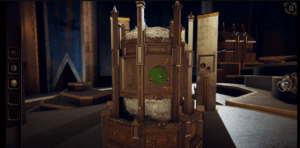For this week’s critical play, I played The Room Three, the third game in The Room series. This is a puzzle game developed by Fireproof Games. It is available on iOS, Android and PC. I played the game on PC. I haven’t completed the game, but have played about 3 hours of the game so far. The game is intended for those who enjoy solving puzzles and enjoy a creepy and mysterious atmosphere in their games.
Puzzle is a core aspect of The Room Three. In the game, players have to navigate through different rooms with puzzles created by the “Craftsman” to escape a mansion, similar to real-life escape rooms but in a digital format and done solo. The mechanics of the puzzles in the game come together to provide a fun, mysterious puzzle-solving adventure that creates the aesthetics of challenge, sensation and discovery.
Puzzles in this game are generally well-designed in a way that optimizes for player satisfaction. In my 3 hours of play, I’ve encountered a good variety of puzzles in the game, some of which are very creative. These puzzles include challenges like riddles, manipulating objects to uncover secret chambers, deciphering hidden codes and more. None of the puzzles are overly difficult or felt unfair in a way that would cause players to be frustrated. In particular, the game goes out of its way to clue players and remove ambiguities. For example, one feature of the game is an eyepiece that when toggled, allows players to unveil hidden chambers or mechanisms behind walls. After introducing this eyepiece mechanic, the game clearly signals whenever the eyepiece is needed by providing a green color overlay on the objects of interest. This helps to remove ambiguity because it makes it clear when the player should use the eyepiece. Without this signal, the player would have to continuously toggle the eyepiece on everything to find these hidden chambers, which would be very tedious. Another example of good puzzle design is that when an item is used (for example using a key to unlock a box), the item is removed from the inventory if it is no longer needed. This not only keeps the inventory clean, but also avoids players futilely trying to use this item at other places and diminishing their enjoyment of the game. Finally, all the puzzles provide good feedback whenever they are solved. For example, if putting a bunch of letters in the correct position unlocked a drawer somewhere else in the room, the camera immediately pans to that drawer to let the player know. Players are also no longer able to interact with the solved puzzle. This prevents players going in circles or continuing to manipulate a puzzle after it has been solved.

Importantly, although these designs are on the player’s side and shift the game’s balance in favor of the player, they still manage to provide a good challenge. The puzzles are of an appropriate difficulty that makes players satisfied after solving them, appealing to the psychological need for achievement. As I played through the game, it was always very satisfying to finish a sequence of puzzles in a room and see all the pieces come together nicely. Players are also able to choose to receive hints after a set amount of time has passed. These hints make the game more accessible and help players to progress when they are stuck. The hints are separated into different levels, with the first hint giving the least away and gradually getting more obvious about the solution. This is a good design because players are able to experience the aesthetic of challenge even when they use the hint.
One last thing worth mentioning is that the environment of the game like the rooms and the puzzles are very detailed and well-crafted, creating an immersive experience for the player and establishing the aesthetics of sensation. The environment makes the players feel as if they are really trying to escape a mysterious mansion. The puzzles also advance the narrative. As I was playing through the game, I was constantly intrigued by who is the “Craftsman” and why we are brought to this mansion. Each room usually contains a letter by the “Craftsman”, which feeds the player small pieces of the narrative. This also creates the aesthetic of discovery, as players are motivated to solve the puzzles to uncover the next room and find out more about the narrative.




